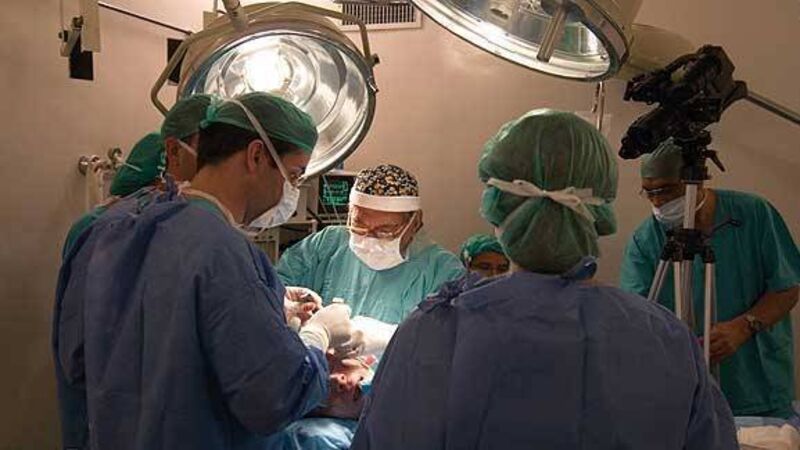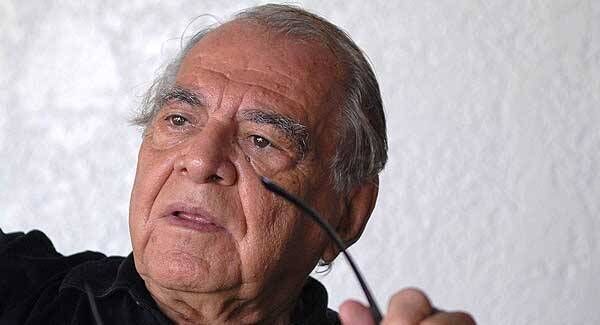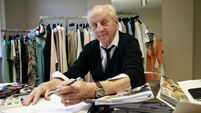Silicone valley on the streets of Rio

IT’S 10 o’clock on a Wednesday morning and I am being guided by a doctor through a series of sweltering corridors in Rio’s Santa Casa de Misericórdia hospital, one of the oldest medical facilities in South America. Brazil may have access to healthcare enshrined in its constitution, but walking around this building, once a convent, it is clear why the middle classes generally tend to avoid the national health system: the infrastructure is dilapidated, the queues long, and, from my brief observations, the hygiene really quite questionable.
However, the atmosphere at our ultimate destination, a lecture theatre in the 38th ward, is rather different. On stage, the professor in charge, a small man in his 80s, is making animated conversation with a prospective patient, a woman in her late 40s. A dozen or so trainee surgeons, from as far afield as the Dominican Republic, Lebanon and Britain, listen intently, occasionally laughing along. The overall vibe is that of a TV chat show.
Until the point at which the patient suddenly disrobes, that is. And the professor lifts one of her pendulous breasts and squeezes it to show how she might benefit from reduction. It’s a startling moment for me — I didn’t, frankly, expect such intimacy when I was invited to spend a day with Ivo Hélcio Jardim de Campos Pitanguy, the most famous plastic surgeon in the world, and a man who has been referred to as “arguably Brazil’s second most famous person after soccer legend Pelé”.
But startling also for Rozina Ali, the 46-year-old British plastic surgeon who has just arrived for a two-week secondment and is sitting on my left. “How undignified for her,” she mutters under her breath.
The patient doesn’t seem to mind at all. And neither do any of the cases that follow: a perfectly pretty student of 17, who complains her nose is “too masculine” and is told in response she will get the nose job she wants and be “made beautiful”; a woman of 50-ish who says “her face doesn’t look how she feels inside” and whose gratitude for a promised facelift takes the form of tears and a request for a selfie with Pitanguy; and a 40-something woman whose bottom has been left misshapen after silicone injections, and who, with her bum still bare, points out her six-year-old daughter in the room, prompting the professor to ask the child, “So, what can we do for you?”

Welcome to Brazil, the world capital of plastic surgery, where copies of Plástica & Beleza (Plastic & Beautiful) sit next to Vogue on news stands, where the 2001 winner of the national beauty pageant had a reported 19 surgical interventions; where, during the ’90s, the number of plastic surgery operations performed multiplied sixfold; where celebrities, politicians, Indian tribe leaders and even activists from the Landless Workers’ Movement talk about the cosmetic work they have done, and where the poor are as keen on nips and tucks as members of high society.
It may seem bizarre in a country still afflicted by extreme poverty that some 54% of people, according to a recent survey, have considered cosmetic surgery (compared with 30% of Americans), that the population should exhibit five times the per capita cosmetic surgery rates of much richer European countries, and that more than 20 public hospitals in Rio should offer discounted or free cosmetic surgery to the poor.
The clinic at Santa Casa, founded more than half a century ago by Ivo Pitanguy, was the first. Indeed, Pitanguy, who has during his long career been nicknamed everything from the “Renoir of rhinoplasty” to “the Botticelli of breast surgery” and “Pope Plastic Surgery”, can be largely credited, or blamed, for the prevalence of plastic surgery in Brazil. The first plastic surgeon to chair the country’s Academia Nacional de Medicina, his hundreds of academic papers are apparently so erudite that they have also earned him a place in the Academia Brasileira de Letras. He also runs the world’s most competitive postgraduate training school for plastic surgeons, with hundreds of surgeons applying for one of 15 spaces each year. He has a list of awards and honorary degrees so long that I give up reading after 15 pages, is fluent in Portuguese, English, Italian, Spanish, German and French and has performed more than 50,000 operations on patients who have reportedly included Sophia Loren, Stan Getz, Zsa Zsa Gabor, François Mitterrand, Brigitte Bardot and Niki Lauda.

Later that same day I go to meet the ambidextrous surgeon at his smart private clinic, Clínica Ivo Pitanguy, based in a gated villa in the Botafogo area of Rio de Janeiro. It could not feel any more different from the public hospital. Instead of being overcrowded, the dark rooms, where the glass in the mirrors is smoked to minimise the shock of post-operative patients, are only partly occupied owing to the preference among the rich of Rio to have surgery in winter.
I am interested in having another stab at a question I’d failed to get an answer to in the morning: wasn’t the 17-year-old girl too young for plastic surgery? “Good question,” comes the instant reply. “She would not be operated on without her parents’ consent. But she will be 18 in April anyway. So it is no problem.” But isn’t it sad that such a pretty girl should want plastic surgery?
“It is not sad — it is the opposite! She wants to improve. And it is a correct decision because she will be much prettier her whole life. I will do her nose, her chin, a very small implant.”
I wince. And tackle the issue from another angle. Should people of her kind of limited financial means be wasting money on surgery? While reconstructive surgery is free at Santa Casa, which is run with help from Catholic charities and some state funding, and while cosmetic patients get their operations at ‘bargain prices’, they still have to make contributions towards basic hospital costs and anaesthesia, even bringing their own sheets and drinks.
“The people you saw this morning are not poor; they are not rich. They are an emerging class.” He takes a sip of water. “But, nevertheless, the service they get is in some ways better than at my private practice. At Santa Casa, all the patients have to undergo a psychological exam before surgery, a health test and social screening. We can also, for example, insist they lose weight before surgery. Whereas with private clients, they can always go to another doctor.”
He pulls his chair closer to me. “But when you speak of plastic surgery there is prejudice in your voice. You associate it with vanity. But plastic surgery is about more than that: it is about becoming happy with who you are.”
At this point Pitanguy articulates, at length, his famous vision of plastic surgery, which he describes as “humanistic” and “anthropological”. He says that when he first started working in a public hospital in Rio the patients whose appearance he improved were often more grateful than the patients whose lives he had saved. This made him come to the view that there was no real difference between reconstructive and aesthetic plastic surgery, because both “heal the psyche”. Or as he famously put it in one paper: “A plastic surgeon is a psychologist with a scalpel in his hand.” He adds that the poor have as much “right” to this “beauty” as the rich.
Pitanguy is remarkably subtle by the standards of his profession. He does not believe in providing patients with computer-generated images of what they will look like after surgery. “My feeling is that if you give someone an image, you are projecting a false idea of what they might become.”
He claims that there is no need for plastic surgery if you are self-confident. “If you have a good ego, you don’t need any surgery … The important thing is that it is there if you need it.” The father of four (ages 45-57), and grandfather of five (ages 16 to 28), he is so articulate on the subject of beauty for the poor that I begin reconsidering my presumptions. If you’re in a favela, and you know beauty might lead to better employment opportunities (research in the West shows that the beautiful have better job prospects) and better marriage prospects, then is having plastic surgery any worse than, say, developing a talent in football?
A common complaint is that he is a better salesman than pioneer. A complaint that can be countered with the simple facts that Ivo Pitanguy has made a number of breakthroughs that are still used in plastic surgery across the world, that his works are still set texts on plastic surgery courses and surgeons still come from abroad to learn from him. Indeed, Rozina Ali, whom I catch up with in London, is gushing with praise. “For aesthetics he is top of the tree,” she observes. “He treats it very seriously, and seeing him in action, coming into surgery every week, I was amazed at how modern he is. He routinely uses the kind of implants in breast surgery, for instance, that are considered too expensive even in Britain and has a very enlightened attitude to patients. I was really astonished by his understanding of people and the human condition in general.”
As well as being the man who made Brazil into a world capital of plastic surgery tourism, Pitanguy, now 87, began his career as a conventional doctor. His father was a surgeon, and so intense was his desire to follow in his footsteps that he lied about his age to get into medical school at 16. After training in America, France and Britain, where his mentors included Sir Harold Gillies, the father of plastic surgery, he persuaded the Brazilian authorities to give him seed money to open the clinic at Santa Casa. Early patients included hundreds of children burnt in a terrible circus fire in Niterói, across the bay from Rio de Janeiro, whom Pitanguy treated for weeks, and a pickpocket whose hand had been filleted by an angered victim.
But over time he began experimenting with cosmetic procedures, performed some of the world’s earliest breast and bottom lifts, transformed sagging stomachs, and began sharing the techniques he had developed. Not only does his career span the 20th-century transformation of plastic surgery from the realm of reconstruction to the realm of the cosmetic, he has also inspired a revolution in types of cosmetic procedure.
The tradition in Brazil used to be for small breasts, but now big breasts are all the rage, which Pitanguy puts down to the influence of globalisation. The country has also let go of its belief in big bums and plumpness: “We now have the problem of obesity, which is interesting,” he says. Men are increasingly turning to surgery, with Pitanguy’s numbers rising from 6% in the 1980s to around 23% now. “But there will always be more women than men … Men have other outlets for ego.’’
And as life expectancies have extended, there has been the rise in surgery among the elderly — with people asking for facelifts in their 70s and 80s. “Actually, the other year I had a German lady in her 80s come to see me, saying she wanted to have a nose job.” Did he operate? “Yes,” he laughs. He is always laughing.
“She said, all my family had this nose, but I don’t want to be buried with it. She was very happy with the results.”









